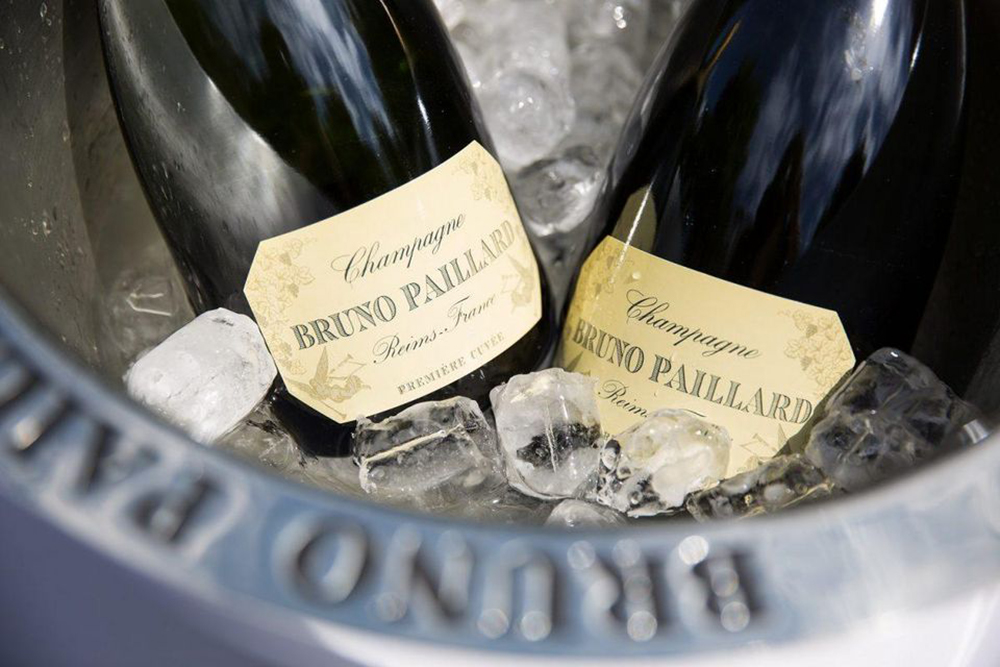
Effervesce sense | Karen Krizanovich on Bruno Paillard
Civilian’s editor-at-large on one of France’s most engaging family-owned and independent champagne houses

Civilian’s editor-at-large on one of France’s most engaging family-owned and independent champagne houses

“I would prefer to live forever in perfect health, but if I must at some time leave this life, I would like to do so ensconced on a chaise longue, perfumed, wearing a velvet robe and pearl earrings, with a flute of champagne beside me and having just discovered the answer to the last problem in a British cryptic crossword.” I agree with Olivia De Havilland, except for the flute.
I don’t drink champagne because I’m a snob. Being a snob is coincidental. I’m simply enthusiastic about champagne. Drinking and writing about it is to demystify the sparkling wine that people love but, when choosing which to try, tend to “cling to shore”. Looking at the champagne shelves, how many people would take a chance on something they haven’t tasted before? As a journalist and hon sec of Guzzlers Anonymous, years of swilling plonk has given me a winey version of PTSD. The remedy? Tasting a lot, slowing down, taking notes, waiting and, the hardest part, thinking. Champagne is its own reward. I doubt if I’m the only person at Tyson Stelzer’s Taste Champagne event whose face gets fatigued from both spitting and smiling. Champagne with other lovers is just the most fun ever. The payback is more sensation, more perception, more wonder and more thrills about what’s in the glass.
So I thought I had no qualms about popping open a Bruno Paillard Première Cuvée M.V. X.B. With a dosage of < 6g/l and disgorged in August 2019 (a Paillard legacy, listing dd on the label for buyers and consumers), I thought I knew what to expect. You know, a low dosage so not sweet. Pinot noir (45%), chardonnay (33%) and meunier (22%) from first pressing and 20% barrel fermented. So, probably complex, a bit oaky maybe, but it looks balanced. But why would a man go to such extremes to start his own house?
Looking at the bottle, with its olde worlde label and dark green hue, I felt as if I were going in to see my bank manager, or for a job interview
“My champagne house is above all a creation of art. I consider that each bottle of champagne that we produce to be a work of art.” It’s a well known Bruno Paillard quote. He grew up in the champagne trade and started up in 1981 with some seed money and by selling his Jaguar. Three years later, in the tricky year of 1984, he took a reported million franc hit by not sending out a vintage that didn’t meet his exacting standards. Bruno Paillard cuvées are aged for a long time and they’re all extra brut. The house states that it uses no herbicides or pesticides and applies only certified organic fertilisers. I know how impressed I was by New Zealand’s Seresin’s biodynamic approach so this intrigued. (If you ever see a bottle of anything with a right hand print on the label, get it – but do check as there are imitators.)
Paillard’s daughter Alice joined the company in 2007 and is now co-manager. Having seen her via live virtual tastings on Instagram (you can see her too @champagnebrunopaillard), Alice said that we rarely look at the name on a bottle of champagne’s label. “It is always the name of a person. Sometimes a name that became a brand,” she said, “…most of the time the name of someone who died 2 or 3 centuries ago, but always the name of a person. It is interesting to consider why: because a fine champagne is above all an act of creation.” Before the grapes, you need to know what you want to make – and in the case of Paillard as a champagne, it is the distillation of the terroir – chalk, elegance, energy and “tension”.
I began to wonder if my mouth, mind and phenomenological vocabulary were up for this. Looking at the bottle, with its olde worlde label and dark green hue, I felt as if I were going in to see my bank manager, or for a job interview. But actually, it was like going for a first date. It was exciting in an anxious way. I pondered cowardice. Maybe I should open a “less challenging” bottle? Having only been disgorged last year, I know it would have aged beautifully.
I should not have been concerned. With Bruno Paillard, you only need to open the bottle and pour it into a glass because the wine does the work for you if you’re willing to watch, listen and taste. It’s dry, of course, with subtle minerality. Toasty, but not brioche sweet. That gives way to fruit – grapefruit, giving way to a tropical zing with a touch of pineapple. It tastes very personal, artisan (in its original sense), tailored as if intended for something quite specific. It’s the kind of bottle you would want to drink with someone you love… or just yourself. It grabs you by the lapel and says, “I want to take you somewhere.” C